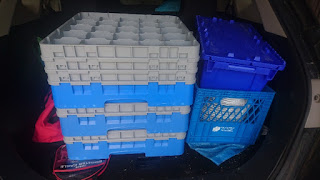One of the things we learn in the MCR course is that everyone approaches waste in different ways. What works for one person might not work for another.
Two weeks ago, Trina G. shared her waste space, to show what works in her home. Today, Alicia C. is sharing a bit about her experiences with worm composting to show us that even the greatest intentions don't always lead to the best solution for everyone.
Do you have a waste-space story to share? We want to hear it! Help your fellow MCRs and waste-conscious readers learn from your experience.
---
Over the last four years I’ve tried worm composting twice. And over the last four years I’ve killed a bunch of worms, twice. It’s a good thing that worms aren’t a protected species.
The first time I tried worm composting, I purchased a kit at
Earth’s General Store. Those worms lasted a couple of years, although I sure don’t know how! The second time I tried worm composting, I created my own “kit” during one of my Master Composter Recycler (MCR) classes. Those worms lasted less than 2 months.
Conclusion—I suck at worm composting!
The question, however, is whether I should try again. My answer is…no. I think I’ve murdered enough worms to last me at least a decade or so.
 |
I'm sorry, worms!
Photo provided by the City of Edmonton |
You might be wondering why an MCR is writing about giving up on worm composting. I'm sharing my story because you shouldn’t be ashamed if you, too, have failed at worm composting. You shouldn’t be pressured or compelled to try again, if it just doesn't work for you.
Worm composting is great, if you have the lifestyle which allows it to be successful. But if you don’t have the time or skills, it doesn’t mean you care any less about waste management or the environment.
Even though I’ve decided not to try again, my analytical brain has been wondering why I’m not successful and I think I've figured out why. I suck at worm composting because...
I hate to cook!
Because I hate to cook, I rarely cook. And when I do, it’s usually not a complicated dish with a lot of ingredients. It's something simple, like toast, grilled cheese, Kraft dinner, etc.
Cooking usually means some sort of scraps, like the top from a carrot, the skin of a cucumber, or the peels from a potato. Not cooking means you don’t have any of these things. Making a bowl of cereal or a couple of slices of toast usually doesn’t create scraps. Nor does eating take-out food, unless you don’t finish your meal. Even then, only some of the unfinished items would be compostable in a worm bin.
I’m also a single person who lives on her own, and the food scraps I do create are not always appropriate for a worm bin. For example, a couple of months ago I bought a “box” (yes, a box) of naval oranges at Costco. I can’t remember exactly how many oranges were in the box, but let’s assume at least 20. As the only one who would be eating these oranges, and not wanting them to go bad, I usually ate 2 a day. This created a LOT of orange peel scraps. If you know anything about composting, especially on a small scale, you know that balance is key. Strong foods (like citrus scraps) should be limited in a worm bin, too. Putting 20 oranges' worth of peels in a worm compost is not a good idea.
I want to point out that I didn’t kill my worms with orange peels. I knew I couldn’t put ALL of them in the bin, so instead I researched what else I could do with them. There’s actually quite a lot you can do with orange, lemon and lime peels. (More on that in a future post!) But because I didn’t have any other appropriate scraps to put in the worm compost bin, the worms went without much food. And worms, apparently, can starve!
If you don't cook much, like me, you too will likely find worm composting difficult. And since it’s unlikely that I’m suddenly going to develop an intense need to become a chef, it’s probably best I let the worms live with someone who can actually feed them.
 |
I guess the worms didn't finish breaking down all the tomato seeds in the bin.
Photo provided by Alicia C. |
My story isn't all tragic, and even has a funny ending. The first worm composting kit I bought came with a large Rubbermaid bin and soil as a place for the worms to live. Last summer, since the worms were dead, I dumped the soil from the bin into one of my gardens. This year I have 3 tomato plants growing in that same garden, which I did not plant! Ironically, I usually kill the tomato plants I buy, yet these ones appear to be thriving.
The Rubbermaid bin was also re-purposed as a litter box for my cats. The worms may have been sacrificed, but at least I’ll have fresh tomatoes, and my cats have a decent-sized litter box. I guess we can consider that the circle of life!
 |
Pippin, one beneficiary of the nice, big, new litter box!
Photo provided by Alicia C. |
Alicia Cappello is a graduate of the 2016 class of Master Composter Recyclers. She lives in Edmonton with her 5 cats and is currently a graduate student at the University of Alberta studying Humanities Computing and Library & Information Studies.





















